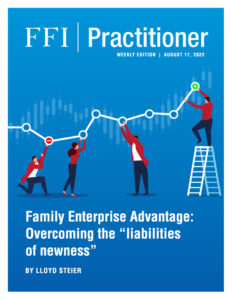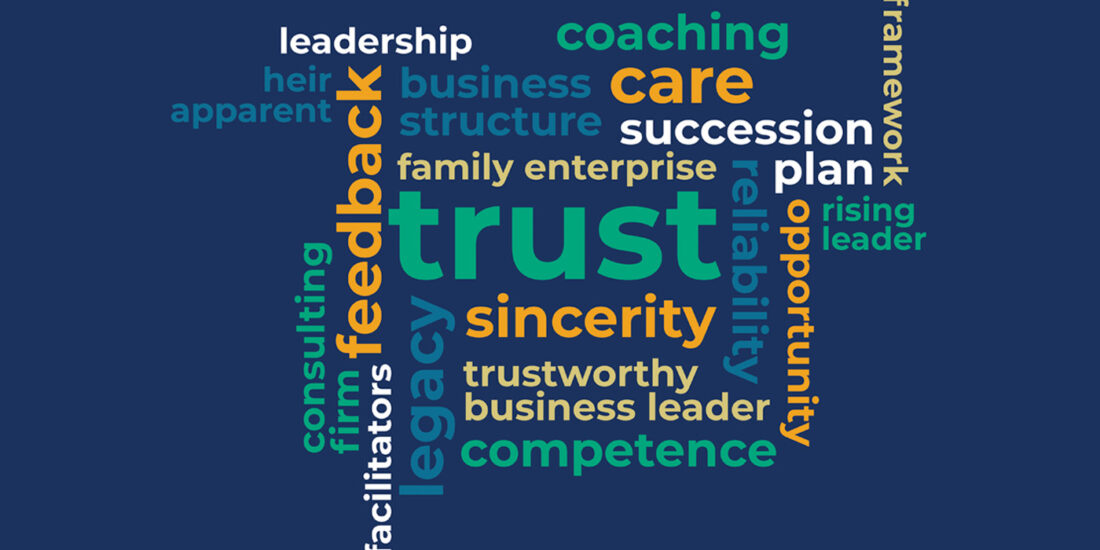
View this edition in our enhanced digital edition format with supporting visual insight and information.
In this week’s FFI Practitioner, FFI Fellow Lloyd Steier provides an overview of the “liabilities of newness” concept and then uses family business examples to illustrate how the concept can be helpful to practitioners by explaining the family advantage in firm creation, survival, and success.
After numerous studies and decades of research, there remains a degree of confusion surrounding the organizing capacity and survivability of family firms.
On the one hand, there is the familiar tenet that family firms are fragile organizations with few surviving beyond three generations. On the other hand, some more recently have challenged the “three generations” myth (for example, see previous FFI Practitioner articles, by Baron and Lachenauer, 2022; and Steier, 2012) and question why there is so much doom and gloom when practitioners and researchers might be better served by exploring the myriad of advantages that familial resources confer to enterprise. I have found a long-established concept in organizational theory, “the liabilities of newness,” extremely helpful in understanding a key familial advantage to firm longevity. This article highlights the key precepts of the “liabilities of newness” and uses real life examples to illustrate how the concept usefully explains family advantage in firm creation, survival, and success.
Overview of the Liabilities of Newness
New ventures (both family- and nonfamily-owned) face a unique set of challenges at the time of their founding. The American sociologist, Arthur Stinchcombe (1965, p. 148) labelled these challenges the “liabilities of newness.” These liabilities have four elements:
- Organizational actors must learn new roles.
- New roles and routines must be invented.
- New organizations must rely heavily on social relations among strangers.
- These new relationships are often much more precarious than the established relationships found in older organizations.
These four elements require that entrepreneurs both learn new routines and establish new relationships, consistent with the strategic intent of the new venture. However, for family firms, their inherent “familiness” can potentially offer the new business a unique bundle of resources helpful in both overcoming the liabilities of newness as well as the ability to derive a long-term competitive advantage.
Real World Family Enterprise Examples
Two examples help demonstrate how family ownership can offer a powerful repository of useful resources in a firm’s founding and growth. Both were new ventures within the global packaged salad industry—a market that has enjoyed tremendous growth in recent years. I became involved with the first company as part of a large research project on entrepreneurship. It was founded by two enthusiastic engineers based on the concept of hydroponically growing and selling bagged lettuce through retail outlets in Canada. The company was eventually funded by a venture capital syndicate. Unfortunately, this promising firm failed when the venture capitalists did not approve late-stage financing. In retrospect, the founders encountered numerous problems associated with the “liabilities of newness.” They were preoccupied with the growing process and issues related to production, they were unable to negotiate appropriate shelf space with grocery retailers, and their relationships with their venture capital partners broke down—the syndicate created some delays in releasing funding in a timely fashion after milestones had been reached.
Alternatively, another firm within the same industry had a markedly different experience mobilizing familial resources. I was introduced to this Australian-based company at a family business conference in Europe. The founder was being celebrated for creating a successful firm (close to a billion dollars in sales) in the bagged lettuce industry. How did he become successful? To paraphrase his explanation, “My father was in the produce distribution industry in Australia. While visiting the U.S., I noticed bagged lettuce was popular and I thought it might sell in Australia. So, I came home, ‘chop, chop’, put it in a bag, and sold it.” This process sounds remarkably simple compared to the earlier example. In reality, the Australian entrepreneur was able to leverage a complex array of resources, relationships, and routines. This entrepreneurial phenomenon, the creative mobilization and bundling of familial resources, occurs throughout the world.
Although the next generation is commonly viewed as the catalyst for creating new firms and spinoffs, other generations may also invoke the “roles, recipes, and routines” associated with overcoming the liabilities of newness. For example, senior generations get involved. Consider the case of a successful concrete pumping business. After nearly 35 years in business, the founder turned much of the business over to his children and made a concerted effort to let them run the day-to-day operations of the business. He then became involved in developing a waste disposal and temporary fencing service for various construction job sites. Again, this idea came from within an industry that he knew well, and he was subsequently able to parlay the existing roles, routines, and relationships into business success.
As part of a research project I conducted with YPO in Canada, I identified members who came from business families and conducted a series of interviews. Initially, I used a standard entrepreneurship interview protocol that began, “Tell me about your firm.” The most common response I received to this question was, “Which one?” I soon adjusted my protocol as it was clear that, although these individuals may have relied on familial resources in the venture creation process, they were engaged in “serial” or “portfolio” entrepreneurship. One interviewee invoked a “seed metaphor” as a way of thinking about familial resources. To paraphrase his example:
In my twenties, I wanted to be independent and do my own thing. I wasn’t interested in working in the business my parents had founded and told them so a number of times. One day, my father took me to lunch and told me the opportunity to take over the business would soon be gone as he was nearing retirement. I re-iterated that I wasn’t interested as I wanted to do my own thing. His response was, “I know you think of it as a large business, but all I have created is a seed. I want to take that seed and pass it on to you. You can grow it how you wish.” I tried working in the business and, within six months, I was hooked. Although there were many challenges, there were many opportunities that I never could have generated on my own.
Overall, the population of family firms exhibit a remarkable diversity and resilience. When a single-family firm disappears from a database, we often confuse an exit as a failure. The field of family business research and advising might better serve family firms by adopting the view that family firms are adaptive systems. Family firms are uniquely positioned to bundle and leverage a unique array of resources for business success.
Concluding Thoughts for Practitioners
For all firms, competitive advantage is a matter of mobilizing and leveraging resources consistent with strategic intent. Family firms continue to survive and thrive throughout the world because they are doing something right. The liabilities of newness concept and its associated propositions offer a helpful way of thinking about what these advantages might be. For advisors, working with family firms requires establishing an appreciation of these resources.
Questions to Consider
- Are family business advisors purveyors of doom and gloom regarding the viability of family businesses or should these practitioners view them as rich repositories of resources that can be leveraged for business—and societal—advantage?
- Do advisors devote too much attention to dividing the proverbial pie when we might be better focused on ways of expanding it?
- Do advisors focus overly on individuals while undervaluing the family system and long-term processes?
- Do advisors view family legacy as a constraining variable, as opposed to an enabling one?
The liabilities of newness concept offers a useful way of thinking about—and acting upon—family advantage. Ultimately, it offers practitioners an optimistic view of family firm survival and success.
References
Baron, J. & Lachenauer, R. (2022, April 19). Success or Failure? Rethinking the three generation rule. FFI Practitioner. https://ffipractitioner.org/success-or-failure-rethinking-the-three-generation-rule/
Steier, L. (2014, February 26). Family Advantage: Why all the doom and gloom. FFI Practitioner. https://ffipractitioner.org/family-advantage-why-all-the-doom-and-gloom/
Stinchcombe, A. L. (1965). Social Structure and Organizations. In J.G March (Ed.), Handbook of organizations (pp. 142–193). Rand McNally.
About the Contributor

Lloyd Steier, FFI Fellow, is a Professor at the University of Alberta School of Business. He was the recipient of the Barbara Hollander award and is a former vice chair of the FFI board of directors. As a researcher and family business advisor he has long been an advocate of celebrating family advantage in business. He can be reached at lsteier@ualberta.ca.

View this edition in our enhanced digital edition format with supporting visual insight and information.





